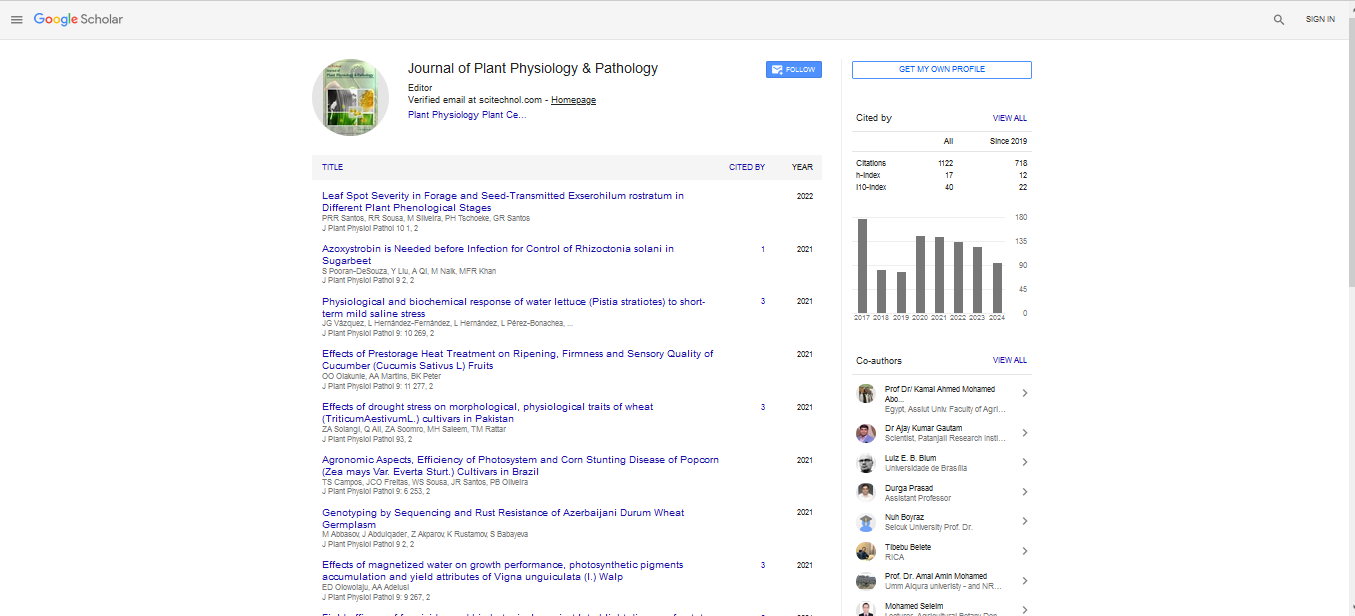Opinion Article, J Plant Physiol Pathol Vol: 12 Issue: 4
Resistance Mechanisms and Breeding for Root Rot Resistance in Crop Plants
An Zhu*
1 Department of Plant Nutrition, Northwest A&F University, Yangling, China
*Corresponding Author: An Zhu,
Department of Plant Nutrition, Northwest A&F
University, Yangling, China
E-mail: an.zhu.nu@edu.in
Received date: 26 June, 2024, Manuscript No. JPPP-24-143438;
Editor assigned date: 28 June, 2024, Pre QC No. JPPP-24-143438 (PQ);
Reviewed date: 15 July, 2024, QC No. JPPP-24-143438;
Revised date: 23 July, 2024, Manuscript No. JPPP-24-143438 (R);
Published date: 31 July, 2024, DOI: 10.4172/2329-955X.1000351
Citation: Zhu A (2024) Resistance Mechanisms and Breeding for Root Rot Resistance in Crop Plants. J Plant Physiol Pathol 12:4.
Description
Root rot diseases, caused by a variety of pathogens including fungi, oomycetes, and bacteria, are a major threat to crop productivity worldwide. These diseases can lead to significant yield losses, economic damage, and reduced plant health. Developing resistant crop varieties is a essential strategy in managing root rot diseases. This involves understanding the resistance mechanisms in plants and employing advanced breeding techniques to enhance these traits.
Root rot pathogens such as Phytophthora, Pythium, Fusarium, and Rhizoctonia species infect plant roots, leading to symptoms like root decay, wilting, and stunted growth. These pathogens thrive in moist, poorly drained soils and can persist in the soil for long periods, making them difficult to manage through conventional means alone. Plants have evolved a variety of defense mechanisms to protect against root rot pathogens. These can be broadly categorized into pre-formed (constitutive) defenses and inducible defenses. The plant cell wall is the first line of defense. It consists of cellulose, hemicellulose, and lignin, which provide structural integrity and act as a physical barrier against pathogen invasion. A robust root system with well-developed lateral roots can limit pathogen spread by enhancing overall root health and function. Plants secrete various compounds from their roots that can inhibit pathogen growth. These include phenolics, flavonoids, and terpenoids. Compounds like saponins and tannins can deter pathogens from establishing infection. Pattern Recognition Receptors (PRRs) These receptors on the plant cell surface recognize conserved Pathogen-Associated Molecular Patterns (PAMPs), triggering the first layer of defense known as PAMP-Triggered Immunity (PTI).
Reactive Oxygen Species (ROS) The production of ROS at infection sites helps to strengthen cell walls and signal further defense responses. Hormones such as Salicylic Acid (SA), Jasmonic Acid (JA), and ethylene play essential roles in regulating defense responses. Hypersensitive Response (HR) Localized cell death at the infection site can limit pathogen spread. Systemic Acquired Resistance (SAR) a plant-wide defense response that provides long-term resistance to a broad spectrum of pathogens. Genes encoding Pathogenesis-Related (PR) proteins, chitinases, and glucanases are upregulated in response to pathogen attack. Breeding for disease resistance involves several steps, including identifying resistant germplasm, understanding the genetic basis of resistance, and incorporating resistance traits into commercially viable varieties through conventional and modern breeding techniques. Large-scale screening of germplasm collections in the field and greenhouse conditions helps identify resistant lines. Detailed phenotypic characterization of resistance traits, such as root health, pathogen load, and yield under infection, is essential. Identifying genomic regions associated with resistance traits using Quantitative Trait Locus (QTL) mapping helps in understanding the genetic architecture of resistance.
Genome-Wide Association Studies (GWAS) enables the identification of resistance genes by correlating genetic markers with phenotypic data across a diverse population. Cross-breeding resistant and susceptible lines to combine desirable traits. The progeny are then selected for resistance and agronomic performance. Introgression resistance genes from wild relatives or landraces into elite cultivars while retaining the desirable traits of the elite cultivar. Marker-Assisted Selection (MAS) using molecular markers linked to resistance genes to select for resistant individuals in breeding programs, speeding up the breeding process. Predicting the breeding value of individuals using genome-wide markers, allowing for the selection of the best candidates for further breeding. Introducing resistance genes from other species or synthetically designed genes into crops using techniques like CRISPR/ Cas9 or transgenic approaches. Resistance to Phytophthora infestans, the causative agent of late blight, has been improved through the introduction of resistance genes from wild potato species. The Rpi genes have been successfully transferred into commercial varieties. Breeding for resistance to Phytophthora sojae involves the use of QTL mapping and Marker-Assisted Selection (MAS). The Ribosomal Proteins (RPS) genes provide race-specific resistance, and efforts are ongoing to pyramid multiple resistance genes to achieve broadspectrum and durable resistance.
 Spanish
Spanish  Chinese
Chinese  Russian
Russian  German
German  French
French  Japanese
Japanese  Portuguese
Portuguese  Hindi
Hindi 
